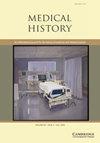全面预防:日本血吸虫病史
IF 0.9
2区 哲学
Q4 HEALTH CARE SCIENCES & SERVICES
引用次数: 1
摘要
摘要在日本,血吸虫病在山梨县和宫室螺生活的几个热点地区流行。这种寄生虫的生命周期依赖于中间的Miya 'iri蜗牛和人类宿主。寄生虫卵通过未经处理的用作肥料的夜间土壤或通过日本农村露天排便的培养进入农业环境。人工稻田和灌溉沟渠、夜间土壤覆盖的稻田和高度精细的生长季节,使人们在洪水泛滥的稻田里,在春夏两季密集地耕种土地。这种疾病依赖于人类对自然世界的干预就像依赖于自然世界对人体的干预一样。强调环境和文化在致病方面的作用是很重要的。本研究假设,我们将战前和战后的全国动员,以重塑环境和改革农村部门的文化,以配合公共卫生任务和卫生现代化的概念,作为全面预防的一个案例。本文章由计算机程序翻译,如有差异,请以英文原文为准。
Total prevention: a history of schistosomiasis in Japan
Abstract In Japan, schistosomiasis was endemic in Yamanashi Prefecture and a few other hotspot areas where the Miya’iri snail lived. The parasite’s lifecycle relied on the intermediary Miya’iri snail as well as the human host. Parasite eggs passed into the agrarian environment through untreated night soil used as fertiliser or through the culture of open defecation in rural Japan. Manmade rice fields and irrigation ditches, night soil covered paddies and highly refined growing seasons put people in flooded rice paddies to intensively work the land in the spring and summer. The disease was equally dependent on human intervention in the natural world as it was on the natural world intervening in the human body. It is important to stress the role of both the environment and culture in disease causation. This study posits that we view the pre- and post-war national mobilisation to remake the environmental and reform the culture of the rural sector to align with public health mandates and notions of hygienic modernity as a case of total prevention.
求助全文
通过发布文献求助,成功后即可免费获取论文全文。
去求助
来源期刊

Medical History
医学-科学史与科学哲学
CiteScore
1.60
自引率
0.00%
发文量
25
审稿时长
>12 weeks
期刊介绍:
Medical History is a refereed journal devoted to all aspects of the history of medicine and health, with the goal of broadening and deepening the understanding of the field, in the widest sense, by historical studies of the highest quality. It is also the journal of the European Association for the History of Medicine and Health. The membership of the Editorial Board, which includes senior members of the EAHMH, reflects the commitment to the finest international standards in refereeing of submitted papers and the reviewing of books. The journal publishes in English, but welcomes submissions from scholars for whom English is not a first language; language and copy-editing assistance will be provided wherever possible.
 求助内容:
求助内容: 应助结果提醒方式:
应助结果提醒方式:


